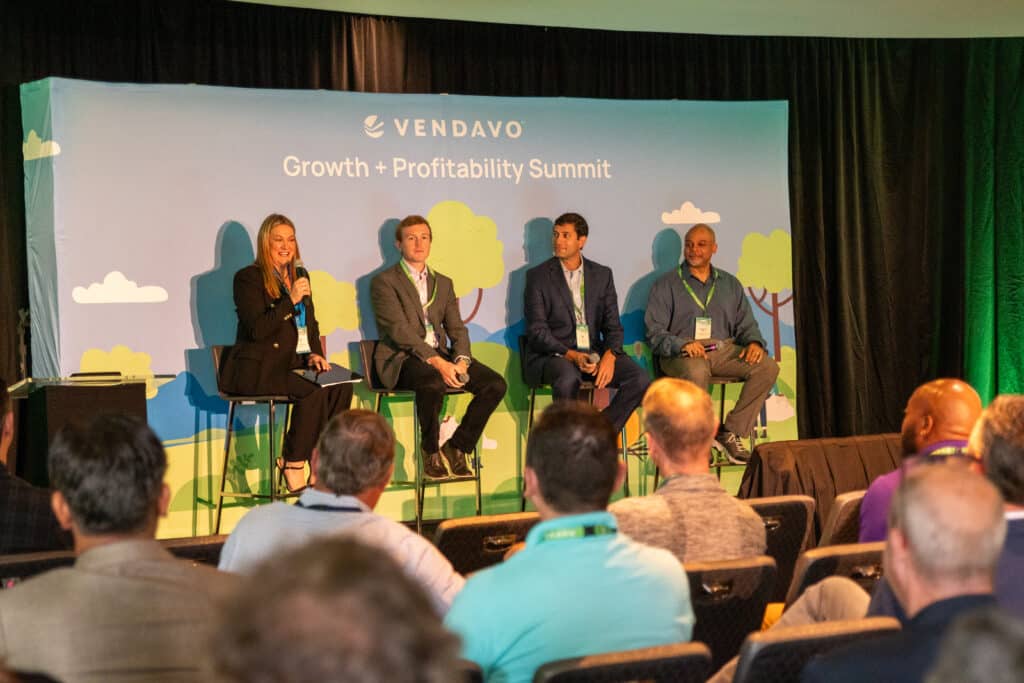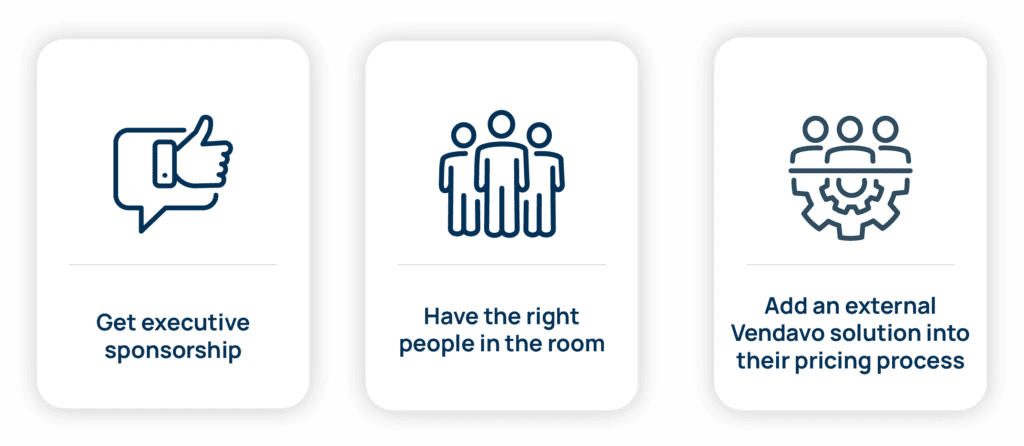
Silos are everywhere and can easily make your everyday operations less efficient. Getting rid of these invisible barriers that prevent in-house information sharing is key to streamlined processes and better results. Let’s dig into the key takeaways that came from the “Pricing Without Walls: Tearing Down Silos to Achieve Better Results” panel moderated by Gina Bates, Chief Revenue Officer at Vendavo, at the recent Growth + Profitability Summit in Chicago.
Everyone has experienced a silo at some point in their career. Silos are those invisible collaboration and communication barriers between departments that can hinder progress and innovation. Breaking them down is key to achieving better results, especially in today’s fast-moving and ever-evolving business landscape.
A panel at our Growth + Profitability Summit in Chicago explored this issue and featured experts sharing experiences and strategies for mitigating silos, driving revenue growth and improving bottom lines. The discussion was moderated by Gina Bates, Chief Revenue Officer at Vendavo, and included insights from Ryan Wallace, Director of Product Pricing at Cardinal Health; Reid Garrett, Vice President of Merchandising at TruckPro; and Frederick Waithe, Director of Strategic Pricing at Dentsply Sirona.

Here’s what we learned during the “Pricing Without Walls: Tearing Down Silos to Achieve Better Results” panel discussion.
How to Recognize Organizational Silos
It can be difficult to identify silos within an organization, let alone how to address them. They tend to happen because specific teams become accustomed to generating, using, and storing the information they need to complete their everyday work, separate from other groups. This creates problems because it means only certain teams have access.
While it’s easy to see the detrimental impacts of silos, the panel noted they are often not created on purpose or to cause problems.
“They don’t always come from ill-intentioned people,” Garrett explained. “Silos often have good intentions. They’re created by teams that are working well together, by well-intentioned people trying to do what they thought was a good job.”
Those well-intentioned people typically fall into three major areas, Garrett noted:

- The people in charge of execution, who may have done their own pricing and negotiating for their entire careers
- The people in charge of support, who need to understand the criticality of removing silos and that the programs introduced to do so are not just “another integration or tool” for business
- The key stakeholders, who have been responsible for the projects that may have inadvertently resulted in silos
Wallace added that silos are funny because they impact everyday activities, so the goal becomes simplifying processes and strategies. You need to gain company-wide buy-in and get everyone on the same page to break down existing silos and avoid creating new ones.
“Very few people show up thinking, ‘How can I make someone else’s life more challenging each day?’” Wallace said. “Most want to do what they feel is best for the organization and to drive profitability, but there’s a different or less clear outcome as to how you get there. I always say take what you think is simple, and then simplify it twice more. That’s the level to gain buy-in across the organization.”
The concept of silos goes beyond just data gathering and storage, though.
“It’s not just the silos we make as individual teams or structures,” Waithe added. “It’s also the mental silos that we have as individuals that kind of lock us into engrained processes that may not be the most optimal processes for the business.”
Impact of Silos on Revenue Growth
Companies not undergoing transformation-related activities are relying on their current state to both achieve their goals and predict future needs. Unidentified silos can then lead to unintended inefficiencies, costs, or losses.
“We have a lot more work to do to understand the full impact,” Waithe noted, “but in our business, we have to either innovate or we’re going to get swallowed up and die.”
He emphasized that relying on outdated processes, customer segmentation, and product line categorization hampers innovation, and that breaking down these silos – both physical and mental – is essential to unlocking pricing’s full potential.
“We’ve got to be able to bring separate products together, and that requires us to think outside of the box,” Waithe added. “We have to innovate how we think about pricing and value. We’re relying on outdated segmentation of our customers and product lines and translating that into how we build the price structures. There’s a lot of potential value we can unlock by unleashing that.”
A reframe like this will help companies grow, he explained, including those looking to scale into new markets or around the globe.
Strategies to Address Silos
The discussion then shifted, with Bates asking what organizations can do to fix company silos.
Garrett explained that everyone is pretty good at identifying a problem and saying, “Well, that’s a silo,” but the real secret sauce is in what you do about it once that silo is identified. Three things helped TruckPro, because they had to:

Executive sponsorship mattered because of the “criticality of the initiative,” Garrett explained. It was “not just a pricing project. It was a TruckPro project.” They needed the right people in the right roles, because “having that broad spectrum helped us have a better implementation and gave a lot of people ownership in what they built.”
Adding a Vendavo software solution helped TruckPro solve a lot of pricing paint points at the same time, because it was easier to quote and simpler to automate pricing guidance. This gave the company faster response times and improved analytics.
Wallace said the Cardinal Health team “wants to do the right thing,” but has different perceptions as to what that might be. But this can actually help strengthen the end results.
“Take the person that’s the biggest naysayer and put them on the panel,” he said.
Eventually, they’re either going to prove the panel wrong and go their normal route, or they’ll say “Oh, this makes sense.” When that happens, you’ve turned one of your more vocal critics to be an advocate. They’ll create a bridge and the folks in the middle can then more quickly come along, and you’ll be minimizing or avoiding silos entirely.
How to Align Sales Goals with Margin Objectives
Measurement is critical once you have a pricing plan in place. The panel agreed that your organization needs to set key performance indicators (KPIs) to track implementation and progress.
“We primarily measure two things: pricing adoption, and profitability or margin,” Garrett said. “We needed to be clear on those two KPIs and enable the reporting to go down to the individual product categories of pricing performance.”
TruckPro found that their best employees had the hardest time adopting the pricing software because it was tough for them to change their thinking patterns. The company used these opportunities to have “coaching conversations” and give others actionable insights.
Wallace agreed and added that it can be easy to forget the steps along the way – and this can be a shortfall for companies.
“We talk so much about what doesn’t go well, but you can learn just as much from what did,” Wallace explained. “Pick three things you should have done better, and then find the three things you did well and use both going forward.”
During each new Cardinal Health project, everyone works hard to “demonstrate that ‘hey, this software, this strategy may seem like a nuisance, but it drove this amount of results to the bottom line.’” Rolling earnings-related results up to the executives goes a long way.
Waithe added that each person in a leadership position needs to be willing to raise their hand and “be the lightning rod” for the organization.
“We got approval to go forward with this implementation because we were solving a critical issue for the business that came with a lot of pressure, an insane timeline, and high expectations, but that also had approval from the very top of the organization,” Waithe said. “That cleared out a lot of obstacles that we would have otherwise spent potentially years trying to fight our way through.”
It’s not a cookie-cutter approach, and there’s no secret formula to successful implementation. Instead, companies must be sensitive to their particular business and industry needs, as well as special circumstances.
Potential Pitfalls of Your Pricing Project
Implementation of any software solution is a big change, but organizations can’t wait until everything is perfect to dig in. The process should be iterative, and you could wait forever if you’re waiting for perfect data.
“You wouldn’t be able to clean it up ahead of time because you don’t know exactly what your pricing waterfall will be,” Garrett noted.
“Garbage in, garbage out” is true of data in almost any tool, Wallace said. That’s one issue. Another is that it can be enticing to quote a more rapid timeline because everyone wants to hear about quick implementation and turnaround. This becomes a problem when you get closer to that deadline, realize you’re not going to hit it, and end up doubling down every day you wait to communicate that there’s a problem. Being up front about problems gives leadership and teammates the opportunity to assist.
“I would encourage everyone to create a similar culture so that folks in your organization feel supported and know that you’re allies, even in the time of tough news,” Wallace said. “You’d rather have 10 people responding to poor news than one person handling it alone.”
This year’s Growth + Profitability Summit in Chicago was filled with exciting panels like this one, and our Stockholm event is coming up soon. Learn more about Vendavo’s annual GPS events as well as the various sessions and panels. To speak with a pricing expert about your organization’s pricing software needs, reach out today.
